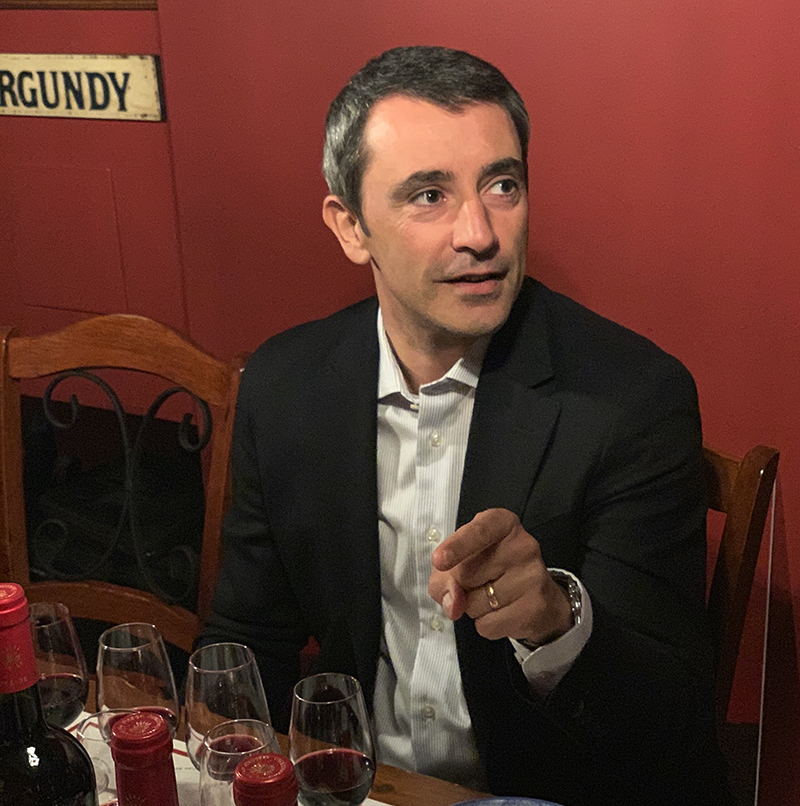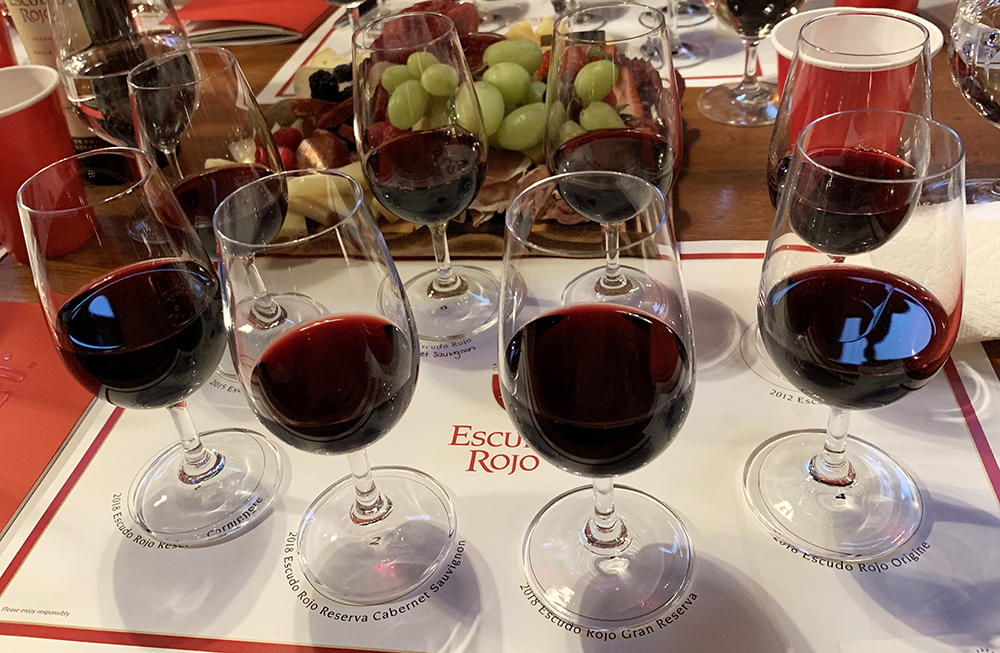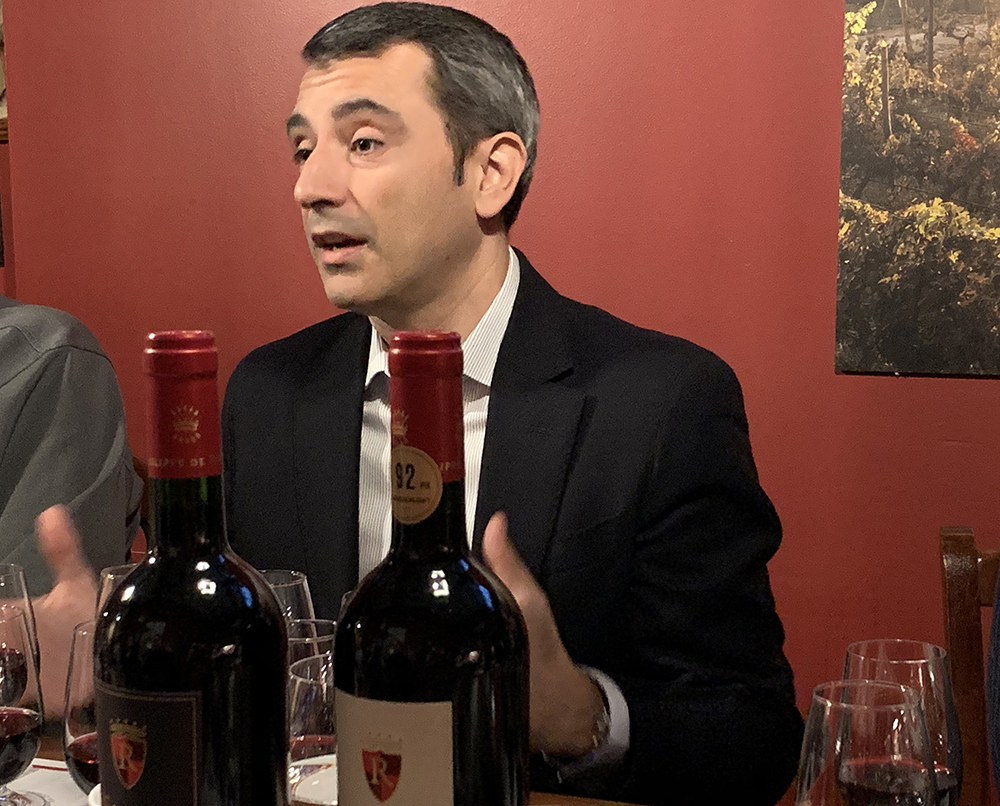
Ontario Wine Culture


Escudo Rojo’s Emmanuel Riffaud explaining the winery’s sustainability initiatives. Photo Michael Di Caro.
I used to think Chile’s long skinny geography flanked by the Pacific Ocean and the Andes Mountains made it a grape growing paradise. With ample heat to fully ripen any grape variety, cool night ocean breezes from the Pacific to keep things fresh and mountainous and oceanic barriers that keep disease away, it’s the platonic grape growing oasis. The only major challenge is ensuring ample water to fight droughts. So, I still think it’s about as ideal as it gets when it comes to growing wine, but I’ve begun to consider Chile’s other major challenges that reveal thatt even paradise isn’t perfect.
When I was invited by Canadian importer Arterra to taste the Escudo Rojo project with Emmanuel Riffaud, who heads-up Chilean arm of his family Baron Philippe de Rothschild wine empire, competitive advantages and challenges are what we talked about.
We touched on what surprised me most about Chile when I visited a decade ago. Chile is fully committed to American-style capitalism in a way that often bests the original. From its network of toll roads that connect virtually any point in the country to Santiago’s skyscraper mega malls with A/C colder than a fridge and Christmas trees taller and more picturesque than the Rockefeller Center. Even the beloved fast food, the completo, which is the hot dog equivalent of putting on your entire wardrobe at once—out does America making a Chicago dog seem like minimalist restraint. Lately American dream has come into question with mass protests in Santiago demanding greater equality. This movement for social progress is trailing the country’s progressive wine commitments on striving for a more sustainable balance, and it’s something that wil need to be addressed sooner rather than later.
In the last few years there’s been a push for Country wide sustainability by the Chilean wine industry (Escudo Rojo is sustainably certified), but for Riffaud Chile’s newest and biggest challenge is to move beyond its mentality of being the upstart willing to undersell on price, oversell on quality and win out with value. The key to making a go at that is to hone in on what makes you special and celebrate it. In other words promote what’s happening in the vineyards. That’s precisely what Riffaud intends to do.

The Escudo Rojo line-up. Photo Michael Di Caro.
The Rothschild Chile project is based in Mapio Valley—the heart of the Chilean wine industry. A little over a half-hour drive from capital Santiago it’s an ideal spot to grow Cabernet Sauvignon. Located a bit closer to the Andes mountain side of the country than the Pacific Ocean it’s got that extra light and warmth that Cab loves, while its namesake river gives just enough night cooling influence to keep the wine tasting fresh. Lately their vineyard philosophy is Burgundy meets Bordeaux exploring what Riffaud calls the “mosiac of terroirs” in their corner of the valley delving into and defining the parcels of grapes—in recent years they’re picking some parcels of grapes up to three times and double sorting with optical sorters to get a fuller spectrum of flavours and endeavoring to make a more complex and complete wine.
That investment in figuring out how to get the best of the vineyard is paying off with the 2018 Riserva Cabernet Sauvignon (Chile, $17.95 Vintages #13434) that’s pure, focused and an absolute pleasure. It tastes of peak summer with black raspberry, blackberry and black currant. Underneath is a touch of vanilla owing to oak aging and a bright, fresh red fruit finish. But what really sets it apart is the structure and texture. It has the rich cappuccino-like texture you want from a big red, while still having the stuffing to age a bit or stand-up to a rich winter dish like short ribs. Yet it’s still accessible and easy drinking on it’s own. If it were a celebrity it’d be a Nicholas Hoult or a Jennifer Lawrence, someone who can easily helm a superhero popcorn flick while still having the chops to effortlessly slide into Oscar-bait dramas.
If you’re looking for something a little more rustic and rugged—the glamping version—the Escudo Rojo line-up has a companion 2018 Reserva Carmenère being released via Vintages April 18th (Chile, $17.00 Vintages # 14058). A decade back there was a push by Chilean wineries to follow the New Zealand signature-grape game plan and make Carmenère their global flagship. Once thought to be nearly extinct, the ultra-late ripening Bordeaux-native blending grape was rediscovered in Chile after it was misidentified for decades as Merlot. This Carmenère showcases the grape’s herbal signature with leafy green mint meets vegetable garden on the nose. But take a sip and it’s all big ripe black plum and cherry topped-off affogato-style with a shot of black espresso that lingers on the finish so predominately you’d be forgiven for thinking someone gave your glass a coffee wash before pouring the wine. There’s a little less structure and the texture isn’t quite as luxurious as its Cabernet colleague, think casual Friday jersey blazer vs. a winter-ready tweed number, but it’s still plenty plush and big enough to impress your partner or dinner guests. It’ll be an ideal transition wine to seek out whether we’re cursing the groundhog come April or breaking out the barbecue early.
Also in the coming years keep an eye out for some ultra premium Cabernets from Escudo Rojo as it looks to prove that you should be looking to Chile first, not Napa or Bordeaux when you want best.

Emmanuel Riffaud talking Carmenère. Photo Michael Di Caro.

Michael Di Caro is a writer and the editor of Vitis Ontario. He has been covering the Ontario wine industry for over a decade. You can find him in the cellar or among the vines uncovering the stories behind the bottle.

Michael Di Caro is a writer and the editor of Vitis Ontario. He has been covering the Ontario wine industry for over a decade. You can find him in the cellar or among the vines uncovering the stories behind the bottle.
Copyright © 2025 - All Rights Reserved Vitis Magazine